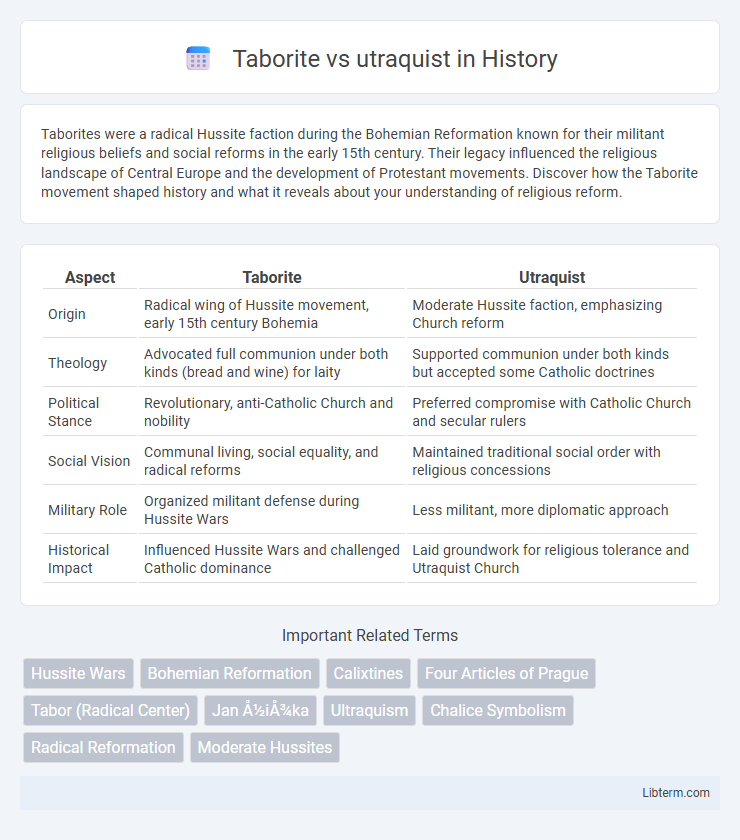Taborites were a radical Hussite faction during the Bohemian Reformation known for their militant religious beliefs and social reforms in the early 15th century. Their legacy influenced the religious landscape of Central Europe and the development of Protestant movements. Discover how the Taborite movement shaped history and what it reveals about your understanding of religious reform.
Table of Comparison
| Aspect | Taborite | Utraquist |
|---|---|---|
| Origin | Radical wing of Hussite movement, early 15th century Bohemia | Moderate Hussite faction, emphasizing Church reform |
| Theology | Advocated full communion under both kinds (bread and wine) for laity | Supported communion under both kinds but accepted some Catholic doctrines |
| Political Stance | Revolutionary, anti-Catholic Church and nobility | Preferred compromise with Catholic Church and secular rulers |
| Social Vision | Communal living, social equality, and radical reforms | Maintained traditional social order with religious concessions |
| Military Role | Organized militant defense during Hussite Wars | Less militant, more diplomatic approach |
| Historical Impact | Influenced Hussite Wars and challenged Catholic dominance | Laid groundwork for religious tolerance and Utraquist Church |
Origins of the Taborites and Utraquists
The Taborites originated during the early 15th century as a radical wing of the Hussite movement in Bohemia, named after their stronghold on Mount Tabor. Utraquists emerged simultaneously as a moderate Hussite faction advocating for communion under both kinds--bread and wine--for laity, reflecting more conciliatory religious reforms within the Catholic Church. Both groups shared roots in the teachings of reformer Jan Hus but diverged sharply in theological and social goals during the Hussite Wars.
Key Theological Differences
Taborites emphasized radical communal living and strict adherence to the Sermon on the Mount, rejecting traditional church hierarchy and sacraments outside of scripture. Utraquists maintained moderate reforms, allowing lay communion under both kinds (bread and wine) while preserving much of the Catholic liturgy and church structure. The key theological divide centered on Taborites' spiritualist and apocalyptic views versus Utraquists' compromise seeking unity within established religious norms.
Historical Background of the Hussite Movement
The Taborites and Utraquists were two primary factions within the Hussite movement, originating in early 15th-century Bohemia after the execution of Jan Hus in 1415. The Taborites, radical followers based in the town of Tabor, advocated for sweeping religious reforms, including communal living and the rejection of certain Catholic rituals. The Utraquists, a moderate faction, sought a compromise by insisting on receiving communion under both kinds (bread and wine) for the laity while maintaining more traditional Church practices.
Political Influences and Alliances
Taborites, representing the radical Hussite faction in Bohemia, secured political influence through alliances with lower nobility and peasant militias, advocating for sweeping religious and social reforms. Utraquists, as moderate Hussites, aligned with the urban bourgeoisie and more conservative nobility, promoting conciliarism and negotiated compromises with the Catholic Church. The political tension between these groups influenced the power dynamics within the Kingdom of Bohemia, shaping the Hussite Wars and subsequent religious policies.
Liturgical Practices Compared
Taborite liturgical practices emphasized communion under both kinds (bread and wine) for all believers, reflecting their radical reformist stance within the Hussite movement. Utraquists also advocated communion under both kinds but maintained more traditional elements, blending Catholic rituals with Hussite reforms. The Taborites rejected many Catholic liturgical ceremonies, favoring simpler, scripture-focused worship, while Utraquists retained a moderate approach, preserving certain rites and clerical hierarchy.
Attitude Toward Church Hierarchy
Taborites rejected the established church hierarchy, advocating for a radical reformation that emphasized communal ownership and criticized clerical authority. Utraquists sought compromise by maintaining a more moderate stance, accepting a two-chambered communion while upholding a traditional ecclesiastical structure. This fundamental difference shaped their respective approaches to church governance and religious practice during the Hussite movement.
Social Impact and Support Base
The Taborites, representing radical Hussite reformers, attracted a largely peasant and lower-class support base, advocating for communal ownership and egalitarian social structures that challenged feudal privileges. In contrast, the Utraquists, with more moderate religious reforms, garnered backing from the urban middle class and nobility, promoting a version of Hussitism compatible with existing social hierarchies. The differing social impacts saw the Taborites push revolutionary changes leading to social upheaval, while the Utraquists sought to maintain social order through negotiated religious compromise.
Military Engagements and Strategies
The Taborites employed mobile war wagons and guerrilla tactics in battles such as the Battle of Sudomer (1420), utilizing terrain to their advantage for swift attacks. Utraquists favored traditional cavalry and infantry formations with defensive positions, evident in engagements like the Battle of Vysehrad (1420). Both factions leveraged Czech Hussite innovations but diverged in strategy, with Taborites emphasizing offensive mobility and Utraquists prioritizing organized defense.
Decline and Legacy of Both Factions
The Taborites faced a rapid decline after their defeat at the Battle of Lipany in 1434, which led to the collapse of their militant resistance and the absorption of their territories by Utraquist forces. The Utraquists, while more moderate, gradually lost influence as the Catholic Church regained control during the Counter-Reformation, diminishing their religious and political power. Despite their decline, both factions significantly shaped Czech religious reform and national identity, laying groundwork for later Hussite and Protestant movements.
Lasting Influence on Czech Christianity
The Taborites, known for their radical reformist stance during the Hussite Wars, emphasized a strict communal lifestyle and symbolic communion, profoundly shaping Czech religious identity through their challenge to Catholic orthodoxy. In contrast, the Utraquists advocated for moderate reforms, including receiving both bread and wine during communion, which helped establish a more conciliatory and enduring form of Hussite tradition within Czech Christianity. The lasting influence of these groups is evident in the continued presence of Utraquist practices within the Hussite Church and the Taborite legacy of reform and social justice that persists in Czech religious and cultural history.
Taborite Infographic

 libterm.com
libterm.com